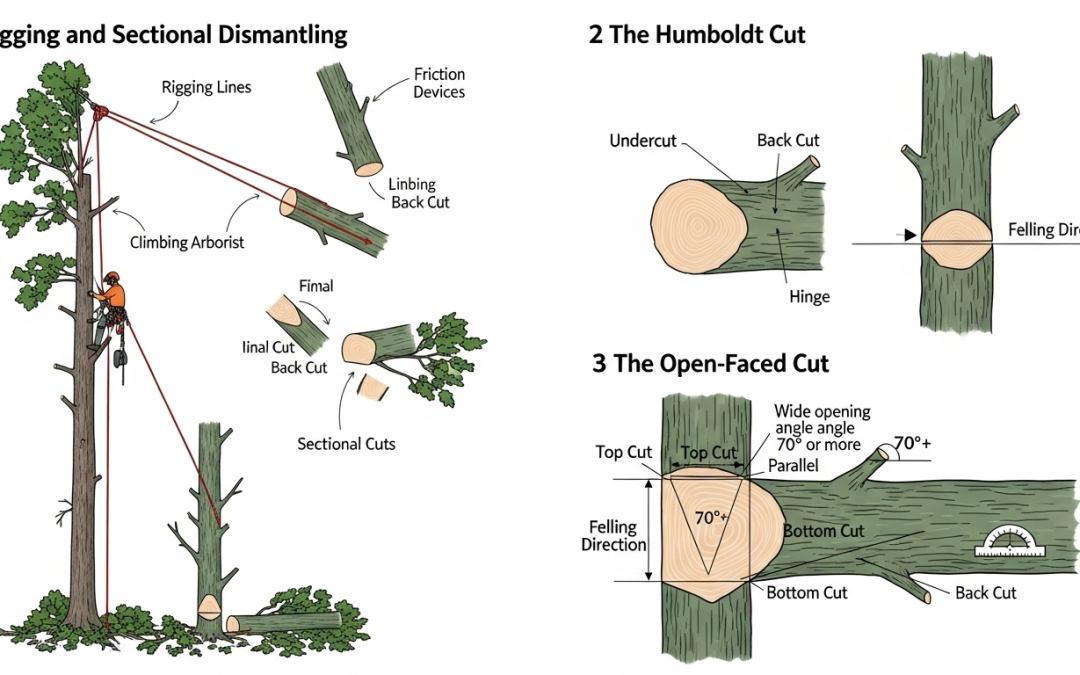The act of tree removal is frequently perceived as a simple endeavor of “cutting down a tree.” Nevertheless, beneath this apparently uncomplicated procedure exists a complex array of techniques and meticulous cuts that demand expertise, understanding, and thorough planning. Professional arborists depend on particular felling cuts and rigging methods to guarantee that the tree descends precisely in the desired location, thereby protecting both property and individuals, while also conserving adjacent vegetation whenever feasible. This article delves into essential tree felling techniques, such as the open-faced cut, the Humboldt cut, and advanced rigging and sectional dismantling.
The Open-Faced Cut
The open-faced cut serves as the fundamental technique employed in the majority of tree felling operations, owing to its dependability and ease of execution.This method entails creating a notch on the side of the tree that is oriented towards the intended direction of the fall. This notch is comprised of two cuts that create an open face:
- Face Cut: The initial cut is made at a downward angle of approximately 45 degrees, resulting in an open, wedge-shaped face.
- Horizontal Cut: The subsequent cut intersects the first at a horizontal angle, creating a notch that is roughly one-third the diameter of the trunk.
This open face serves as a hinge guide, steering the tree’s descent and offering a controlled release point.The remaining hinge wood enables the tree to pivot downwards while ensuring stability throughout the fall. When executed correctly, the open-faced cut minimizes the risk of kickback and enhances precision.
The Humboldt Cut
For trees that display atypical leans, irregular forms, or intricate environments, the Humboldt cut—commonly referred to as the wedge cut—provides enhanced control and safety. This technique involves creating a wedge-shaped notch on the side facing the desired direction of the fall by:
- Removing a triangular wedge of wood rather than a simple notch.
- Creating stabilizing surfaces on both sides of the notch.
The Humboldt cut serves to stabilize the tree during its fall, particularly when the tree’s natural lean opposes the intended direction of the drop. By enlarging the face and accurately shaping the wedge, arborists are able to redistribute forces throughout the felling process, thereby minimizing the risk of erratic bounce or roll. This technique necessitates a sophisticated understanding of tree dynamics and meticulous measurement, yet it enhances safety in difficult circumstances.
Rigging and Sectional Dismantling
In urban or restricted settings where there is insufficient space for a complete tree to fall, arborists utilize rigging and sectional dismantling techniques to safely extract trees in segments. This procedure entails:
- Using ropes, pulleys, and specialized rigging equipment to lower segments of the tree gently.
- Calculating load weights, angles, and tension forces precisely to avoid equipment failure or uncontrolled drops.
- Strategically making cuts so sections can be detached and lowered safely without damaging the surroundings.
Physics is essential as arborists evaluate vectors of force, leverage points, and balance to safely perform each cut and maneuver. Each section of the tree is carefully strategized for removal, typically beginning from the upper branches and working downward, thereby reducing the risk to both workers and property. Rigging methods facilitate effective removal in confined areas, such as near buildings, power lines, or other delicate structures.
Conclusion
Tree felling encompasses much more than merely severing a trunk—it represents a discipline characterized by precision, safety, and control. Ranging from fundamental techniques like the open-faced method to more sophisticated strategies such as the Humboldt cut and sectional dismantling, each method necessitates a high level of technical skill and meticulous calculation. Professional arborists utilize a combination of traditional knowledge and contemporary rigging techniques to guarantee that trees are removed in a safe, efficient manner, while minimizing the impact on the surrounding environment. By gaining insight into these methods, we can enhance our appreciation for the expertise involved in transforming tree removal into a meticulously controlled and highly technical process.

